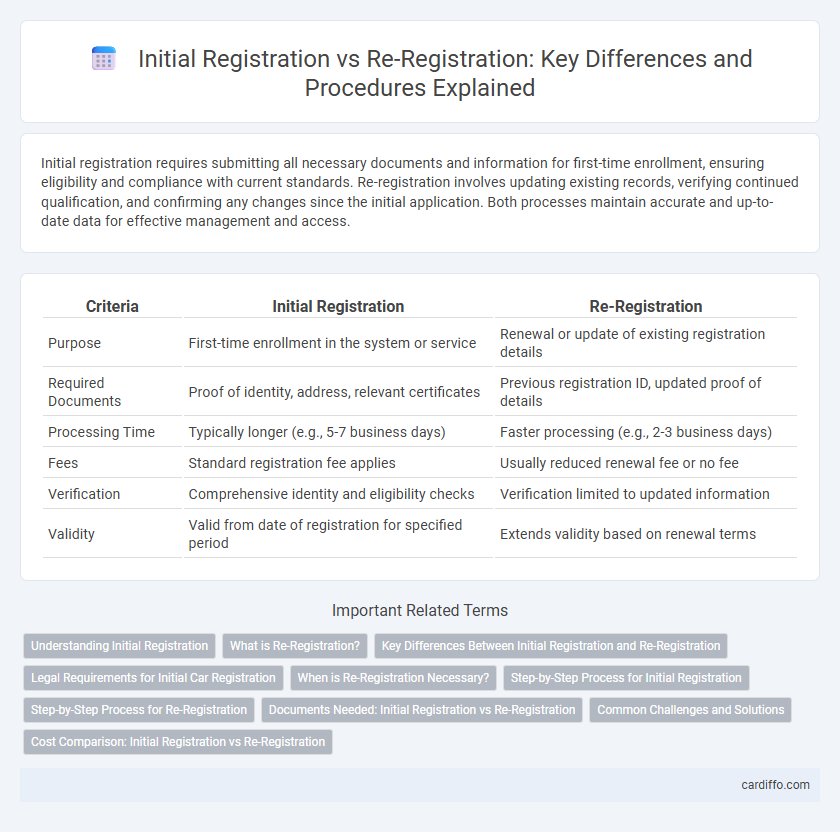Initial registration requires submitting all necessary documents and information for first-time enrollment, ensuring eligibility and compliance with current standards. Re-registration involves updating existing records, verifying continued qualification, and confirming any changes since the initial application. Both processes maintain accurate and up-to-date data for effective management and access.
Table of Comparison
| Criteria | Initial Registration | Re-Registration |
|---|---|---|
| Purpose | First-time enrollment in the system or service | Renewal or update of existing registration details |
| Required Documents | Proof of identity, address, relevant certificates | Previous registration ID, updated proof of details |
| Processing Time | Typically longer (e.g., 5-7 business days) | Faster processing (e.g., 2-3 business days) |
| Fees | Standard registration fee applies | Usually reduced renewal fee or no fee |
| Verification | Comprehensive identity and eligibility checks | Verification limited to updated information |
| Validity | Valid from date of registration for specified period | Extends validity based on renewal terms |
Understanding Initial Registration
Initial registration involves the first-time enrollment of an individual or entity into a system, database, or institution, establishing their unique identity and credentials. This process typically requires submitting foundational information such as personal details, contact information, and relevant documentation to verify authenticity. Understanding initial registration is crucial for ensuring accurate record-keeping and seamless access to services or benefits associated with the registered entity.
What is Re-Registration?
Re-registration refers to the process of renewing or updating an existing registration to maintain its validity or compliance with current regulations. This procedure often involves verifying previously submitted information, making necessary amendments, and submitting updated documents or fees. Re-registration ensures continued access to services, benefits, or legal recognition without interruption.
Key Differences Between Initial Registration and Re-Registration
Initial registration involves submitting personal information and documentation for the first time to create a new account or record, while re-registration requires updating or renewing existing information. Key differences include the necessity of verifying identity and eligibility during initial registration, whereas re-registration focuses on confirming validity and maintaining continuity. Processing times are typically longer for initial registration due to thorough validation, compared to faster re-registration procedures designed to streamline access.
Legal Requirements for Initial Car Registration
Initial car registration requires submitting proof of vehicle ownership, valid identification, and compliance with emissions and safety standards mandated by state law. Owners must complete a title application, pay applicable fees, and provide proof of insurance to satisfy legal requirements. This process establishes the vehicle's official record for taxation, liability, and regulatory purposes distinct from re-registration protocols.
When is Re-Registration Necessary?
Re-registration is necessary when renewing or updating existing registration details to maintain compliance with regulatory requirements or system access. It often applies if there are significant changes in personal information, ownership, or status that must be reflected in official records. Timely re-registration ensures uninterrupted services and validates the legitimacy of the registered entity.
Step-by-Step Process for Initial Registration
The step-by-step process for initial registration involves collecting and verifying personal information, submitting necessary documentation, and completing the online or in-person application form. After submission, applicants typically receive a confirmation and a verification link or code to activate their account. Initial registration ensures unique user identification and access, distinguishing it from re-registration, which focuses on updating existing information.
Step-by-Step Process for Re-Registration
Re-registration involves verifying existing account details, updating personal information, and submitting required documents through the official portal. Users must log in with previous credentials, complete the re-registration form, and confirm changes via email or SMS verification. This process ensures continuity while maintaining data accuracy and compliance with current regulations.
Documents Needed: Initial Registration vs Re-Registration
Initial registration requires original identification documents such as a passport or national ID, proof of address, and any relevant certificates depending on the registration type. Re-registration typically demands updated documents, including the previous registration certificate, current identification, and proof of any changes since the initial registration. Ensuring all paperwork is accurate and complete streamlines the processing time for both initial and re-registration procedures.
Common Challenges and Solutions
Initial registration often faces challenges such as verifying incomplete or inaccurate data, while re-registration typically struggles with updating outdated information and system synchronization. Common solutions include implementing robust validation protocols, automated reminders for users to update records, and integrating secure digital identity verification tools. Leveraging cloud-based registration platforms enhances data accuracy, reduces processing time, and streamlines both initial and re-registration workflows.
Cost Comparison: Initial Registration vs Re-Registration
Initial registration typically involves higher fees compared to re-registration due to processing new account setup, document verification, and system entry costs. Re-registration fees are generally lower since they involve updating existing records rather than creating new profiles, resulting in reduced administrative efforts and expenses. Businesses and individuals benefit from cost savings through streamlined re-registration procedures, enhancing overall registration efficiency.
Initial Registration vs Re-Registration Infographic

 cardiffo.com
cardiffo.com